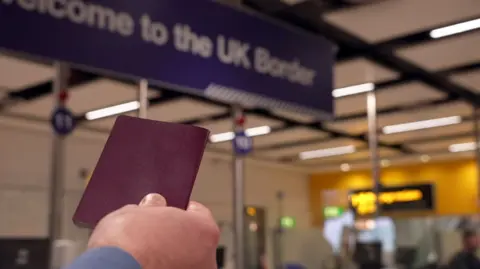Transport reporter
 BBC
BBCIt remains unclear whether UK passport holders will be able to use e-gates at EU airports this summer.
The EU Commission has told the BBC that UK citizens will not have access to them until a new scheme to enhance border security comes into force in October, and even then it is up to individual countries.
When asked if e-gates would be available this summer, the prime minister’s official spokesperson said it was up to individual nations to implement the changes and it would update on “the precise timelines for that… in due course.”
Since the UK left the EU bloc, many popular holiday destinations have seen long queues of British travellers at airports as they wait for passports to be checked.
The new European Entry/Exit Scheme (EES) gathers biometric data on citizens arriving in the EU from non-member, third-party countries, which includes the UK.
After technology delays, it is now due to roll out in October 2025.
Monday’s deal between the UK and the EU says there will be “no legal barriers to eGate use for British Nationals traveling to and from EU Member States after the introduction of the EU Entry/Exit System (EES)”.
An EU Commission spokesperson told the BBC that the introduction of the EES will open the possibility of using e-gates for all non-EU citizens, including UK citizens and mean faster processing at borders.
“Once the EES is in place, UK nationals will therefore be able to use e-gates where they are available, provided they are registered in the system.”
Confusion over timeline
However, Cabinet Office minister Pat McFadden said it was “highly unlikely” passport holders would be able to use EU e-gates this summer.
“The EU is introducing this new entry and exit scheme so nothing is going to happen before that’s in place, and that’s not yet in place. They’ve put the date back for that a few times, the latest date is the autumn, let’s see if that’s stuck to.
“After that it’s up to the member states. But this gives us the possibility, I’d say the probability, that people will be able to use the e-gates in future, which is not a possibility at the moment.”
Some EU countries already allow UK citizens to use their e-gates, so it is possible that talks with individual nations could result in more letting British passengers use their gates this summer.
Surprise inclusion
The inclusion of e-gates in the deal has surprised some in the travel industry, as they had understood the gates were always going to be available to UK passport holders in the EU once EES begins in October.
Julia Lo Bue-Said, chief executive of the Advantage Travel Partnership, an independent travel group, said:
“This new deal appears to offer little more than expanded access to e-gates which are already in use at some destinations and only after the long-delayed digital border system (EES) is introduced, currently planned for an October launch.”
Currently, EU destinations which already allow UK passport holders to use e-gates often then require a secondary check and a passport stamp.
The new deal and EES means UK passport holders will likely no longer require a stamp.
The launch of EES has been in the pipeline for a while. It will see non-EU nationals needing to add their biometric data to a new EU database, which will be done at the point of departure to the EU, either at an airport, port or train station.
